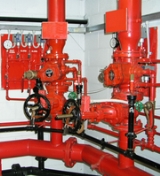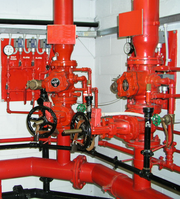
Sprinkler fitting
Encyclopedia

Automatic fire suppression
Automatic fire suppression systems control and extinguish fires without human intervention.According to the National Fire Protection Association, there were 1,602,000 fires reported in the United States in 2005. There were 3,675 civilian deaths, 17,925 civilian injuries, and $9.2 billion in...
systems in all types of structures. Sprinkler systems installed by sprinkler fitters can include the underground supply as well as integrated overhead piping
Piping
Within industry, piping is a system of pipes used to convey fluids from one location to another. The engineering discipline of piping design studies the efficient transport of fluid....
systems and standpipes. The fire suppression piping may contain water, air (in a dry system), antifreeze, gas
Gaseous fire suppression
Gaseous fire suppression is a term to describe the use of inert gases and chemical agents to extinguish a fire. Also called Clean Agent Fire Suppression. These Agents are governed by the NFPA Standard for Clean Agent Fire Extinguishing Systems - NFPA 2001 in the USA, with different standards and...
or chemicals
ABC Dry Chemical
ABC or multi-purpose dry chemical is a dry chemical extinguishing agent. It uses a specially fluidized and siliconized monoammonium phosphate powder. ABC dry chemical is usually a mix of monoammonium phosphate and ammonium sulfate, the former being the active one. The mix between the two agents is...
as in a hood system, or a mixture producing fire retardant foam
Fire retardant foam
Fire-fighting foam is a foam used for fire suppression. Its role is to cool the fire and to coat the fuel, preventing its contact with oxygen, resulting in suppression of the combustion. Fire-fighting foam was invented by the Russian engineer and chemist Aleksandr Loran in 1902.The surfactants used...
.
Sprinkler fitters (sometimes called simply "sprinks") are represented in the USA by the United Association of Journeymen and Apprentices of the Plumbing and Pipe Fitting Industry of the United States and Canada.
Sprinkler fitters work with a variety of pipe and tubing materials including several types of plastic, copper, steel, cast iron, and ductile iron.
Sprinkler fitters specialize in piping associated with fire sprinkler systems. The piping within these types of systems are required to be installed and maintained in accordance with strict guidelines in order to maintain compliance with the local building code and the fire code. This type of fire protection is considered a part of active fire protection
Active fire protection
Active fire protection is an integral part of fire protection. AFP is characterised by items and/or systems, which require a certain amount of motion and response in order to work, contrary to passive fire protection.-Fire suppression:...
rather than passive fire protection
Passive fire protection
Passive fire protection is an integral component of the three components of structural fire protection and fire safety in a building. PFP attempts to contain fires or slow the spread, through use of fire-resistant walls, floors, and doors...
.
Local and national standards
In the USUnited States
The United States of America is a federal constitutional republic comprising fifty states and a federal district...
, fire protection systems must adhere to the standards set forth in the installation standards of NFPA 13, (NFPA) 13D,(NFPA) 13R, (NFPA 14) and (NFPA) 25which are administered, copyrighted, and published by the National Fire Protection Association
National Fire Protection Association
The National Fire Protection Association is a United States trade association that creates and maintains private, copywrited, standards and codes for usage and adoption by local governments...
. While these are set as the minimum installation standards, the authority having jurisdiction must review and approve the design and installation of the piping installed by the sprinkler fitter.
Within the UK the standards used for design, installation and maintenance is BS EN 12845 (British Standards or BS), but more commonly used is the LPC Rules for Sprinkler Installations incorporating BS EN 12845 (originally produced by the Loss Prevention Council (LPC) which is no longer in existence, a small no-government organisation now produces the standard in consultation with sprinkler engineers, designers and insurers/broker) these are based on insurer requirements and best practice and go above and beyond the British Standard. Although not a legal requirement the sprinkler system should be installed by and approved installer, there are a number of approval bodies in the UK, the sprinkler design should also be checked by your insurer, broker or risk advisor. NFPA and FM standards are also accepted within the UK. NFPA tends to be used for more complex installations.
See also
- Automatic Fire SuppressionAutomatic fire suppressionAutomatic fire suppression systems control and extinguish fires without human intervention.According to the National Fire Protection Association, there were 1,602,000 fires reported in the United States in 2005. There were 3,675 civilian deaths, 17,925 civilian injuries, and $9.2 billion in...
- Fire sprinkler system
- Active fire protectionActive fire protectionActive fire protection is an integral part of fire protection. AFP is characterised by items and/or systems, which require a certain amount of motion and response in order to work, contrary to passive fire protection.-Fire suppression:...
- Pipe fittingPipe fittingPipe fitting is the occupation of installing or repairing piping or tubing systems that convey liquid, gas, and occasionally solid materials...

